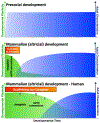Early Adversity and the Neotenous Human Brain
- PMID: 31399257
- PMCID: PMC6935437
- DOI: 10.1016/j.biopsych.2019.06.018
Early Adversity and the Neotenous Human Brain
Abstract
Human brain development is optimized to learn from environmental cues. The protracted development of the cortex and its connections with subcortical targets has been argued to permit more opportunity for acquiring complex behaviors. This review uses the example of amygdala-medial prefrontal cortex circuitry development to illustrate a principle of human development-namely, that the extension of the brain's developmental timeline allows for the (species-expected) collaboration between child and parent in co-construction of the human brain. The neurobiology underlying affective learning capitalizes on this protracted timeline to develop a rich affective repertoire in adulthood. Humans are afforded this luxuriously slow development in part by the extended period of caregiving provided by parents, and parents aid in scaffolding the process of maturation during childhood. Just as adequate caregiving is a potent effector of brain development, so is adverse caregiving, which is the largest environmental risk factor for adult mental illness. There are large individual differences in neurobiological outcomes following caregiving adversity, indicating that these pathways are probabilistic, rather than deterministic, and prolonged plasticity in human brain development may also allow for subsequent amelioration by positive experiences. The extant research indicates that the development of mental health cannot be considered without consideration of children in the context of their families.
Keywords: Amygdala; Brain development; Medial prefrontal cortex; Parents; Sensitive periods; Stress.
Copyright © 2019 Society of Biological Psychiatry. Published by Elsevier Inc. All rights reserved.
Conflict of interest statement
Disclosures: The authors report no biomedical financial interests or potential conflicts of interest.
Figures

Comment in
-
Transforming Psychiatry Through Novel Neuroscience: Computational and Developmental Frameworks Guided by Research Domain Criteria.Biol Psychiatry. 2020 Feb 15;87(4):314-315. doi: 10.1016/j.biopsych.2019.12.006. Biol Psychiatry. 2020. PMID: 32040419 No abstract available.
Similar articles
-
Neurobiological Programming of Early Life Stress: Functional Development of Amygdala-Prefrontal Circuitry and Vulnerability for Stress-Related Psychopathology.Curr Top Behav Neurosci. 2018;38:117-136. doi: 10.1007/7854_2016_42. Curr Top Behav Neurosci. 2018. PMID: 28439771 Free PMC article.
-
Neural meaning making, prediction, and prefrontal-subcortical development following early adverse caregiving.Dev Psychopathol. 2020 Dec;32(5):1563-1578. doi: 10.1017/S0954579420001169. Dev Psychopathol. 2020. PMID: 33427163 Free PMC article. Review.
-
Stress and the adolescent brain: Amygdala-prefrontal cortex circuitry and ventral striatum as developmental targets.Neurosci Biobehav Rev. 2016 Nov;70:217-227. doi: 10.1016/j.neubiorev.2016.07.030. Epub 2016 Jul 26. Neurosci Biobehav Rev. 2016. PMID: 27473936 Free PMC article. Review.
-
Social scaffolding of human amygdala-mPFCcircuit development.Soc Neurosci. 2015;10(5):489-99. doi: 10.1080/17470919.2015.1087424. Epub 2015 Sep 21. Soc Neurosci. 2015. PMID: 26313424 Free PMC article. Review.
-
Previous Institutionalization Is Followed by Broader Amygdala-Hippocampal-PFC Network Connectivity during Aversive Learning in Human Development.J Neurosci. 2016 Jun 15;36(24):6420-30. doi: 10.1523/JNEUROSCI.0038-16.2016. J Neurosci. 2016. PMID: 27307231 Free PMC article.
Cited by
-
Interpersonal early adversity demonstrates dissimilarity from early socioeconomic disadvantage in the course of human brain development: A meta-analysis.bioRxiv [Preprint]. 2023 Feb 18:2023.02.16.528877. doi: 10.1101/2023.02.16.528877. bioRxiv. 2023. Update in: Neurosci Biobehav Rev. 2023 Jul;150:105210. doi: 10.1016/j.neubiorev.2023.105210. PMID: 36824818 Free PMC article. Updated. Preprint.
-
Aberrant cortical projections to amygdala GABAergic neurons contribute to developmental circuit dysfunction following early life stress.iScience. 2022 Dec 5;26(1):105724. doi: 10.1016/j.isci.2022.105724. eCollection 2023 Jan 20. iScience. 2022. PMID: 36582824 Free PMC article.
-
Maternal Psychological Distress and Executive Functions Are Associated During Early Parenthood - A FinnBrain Birth Cohort Study.Front Psychol. 2021 Oct 22;12:719996. doi: 10.3389/fpsyg.2021.719996. eCollection 2021. Front Psychol. 2021. PMID: 34751221 Free PMC article.
-
Prenatal maternal depression predicts neural maturation and negative emotion in infants.Infant Behav Dev. 2023 Feb;70:101802. doi: 10.1016/j.infbeh.2022.101802. Epub 2022 Dec 10. Infant Behav Dev. 2023. PMID: 36508874 Free PMC article.
-
Preliminary examination of the effects of an early parenting intervention on amygdala-orbitofrontal cortex resting-state functional connectivity among high-risk children: A randomized clinical trial.Dev Psychopathol. 2025 Feb;37(1):384-392. doi: 10.1017/S0954579423001669. Epub 2024 Jan 22. Dev Psychopathol. 2025. PMID: 38247369 Free PMC article. Clinical Trial.
References
-
- Kernberg OF, Early ego integration and object relations. Ann N Y Acad Sci, 1972. 193: p. 233–47. - PubMed
-
- Hofer MA, Early relationships as regulators of infant physiology and behavior. Acta Pediatrica, 1994. 83(s397): p. 9–18. - PubMed
-
- Gewirtz JL, Baer DM, and Roth CH, A note on the similar effects of low social availability of an adult and brief social deprivation on young children’s behavior. Child Dev, 1958. 29(1): p. 149–52. - PubMed
-
- Bowlby J, Attachment and loss: retrospect and prospect. Am J Orthopsychiatry, 1982. 52(4): p. 664–78. - PubMed
-
- Bowen M, The use of family theory in clinical practice. Compr Psychiatry, 1966. 75(5): p. 345–374. - PubMed
Publication types
MeSH terms
Grants and funding
LinkOut - more resources
Full Text Sources

